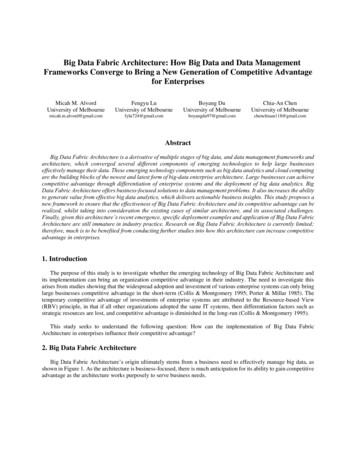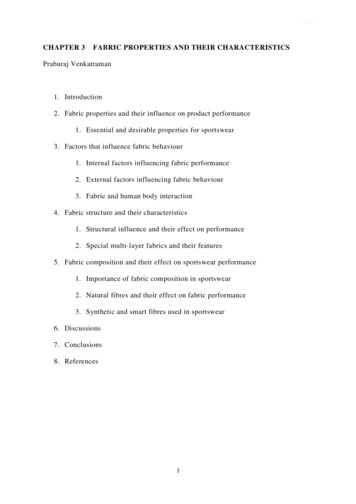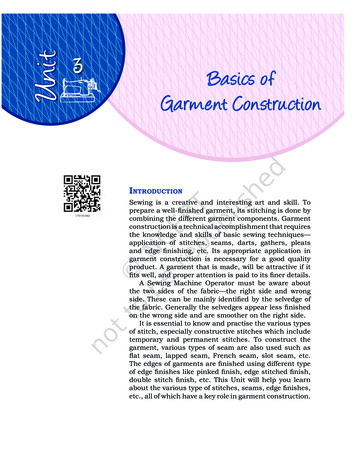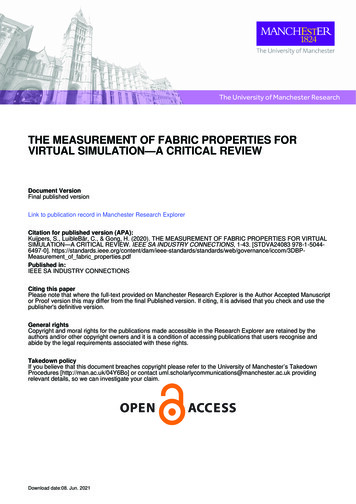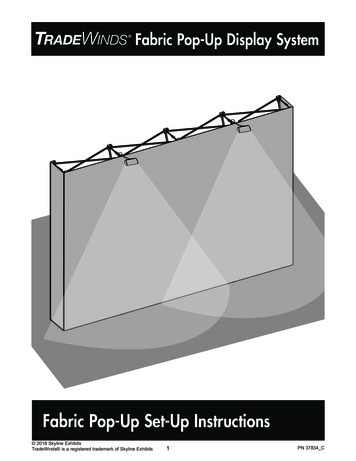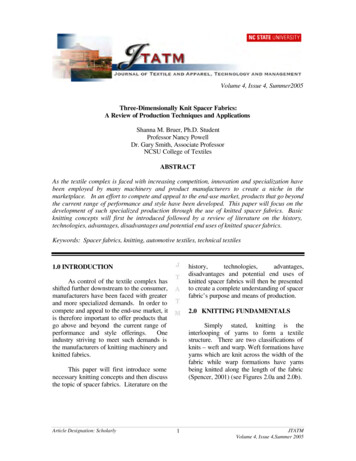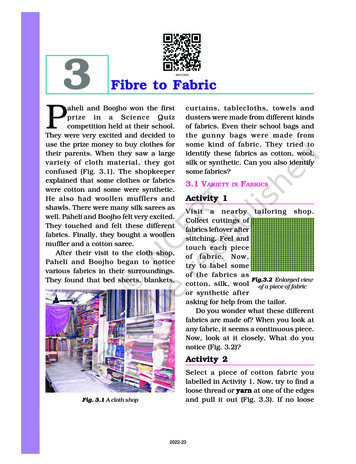
Transcription
3Fibre to FabricPaheli and Boojho won the firstprize in a Science Quizcompetition held at their school.They were very excited and decided touse the prize money to buy clothes fortheir parents. When they saw a largevariety of cloth material, they gotconfused (Fig. 3.1). The shopkeeperexplained that some clothes or fabricswere cotton and some were synthetic.He also had woollen mufflers andshawls. There were many silk sarees aswell. Paheli and Boojho felt very excited.They touched and felt these differentfabrics. Finally, they bought a woollenmuffler and a cotton saree.After their visit to the cloth shop,Paheli and Boojho began to noticevarious fabrics in their surroundings.They found that bed sheets, blankets,curtains, tablecloths, towels anddusters were made from different kindsof fabrics. Even their school bags andthe gunny bags were made fromsome kind of fabric. They tried toidentify these fabrics as cotton, wool,silk or synthetic. Can you also identifysome fabrics?3.1 VARIETYINFABRICSActivity 1Visit a nearby tailoring shop.Collect cuttings offabrics leftover afterstitching. Feel andtouch each pieceof fabric. Now,try to label someof the fabrics asFig.3.2 Enlarged viewcotton, silk, wool of a piece of fabricor synthetic afterasking for help from the tailor.Do you wonder what these differentfabrics are made of? When you look atany fabric, it seems a continuous piece.Now, look at it closely. What do younotice (Fig. 3.2)?Activity 2Fig. 3.1 A cloth shopSelect a piece of cotton fabric youlabelled in Activity 1. Now, try to find aloose thread or yarn at one of the edgesand pull it out (Fig. 3.3). If no loose18SCIENCE2022-23
Fig. 3.3 Pulling a thread from a fabricyarns are visible, you can gently pullone out with a pin or a needle.We find that a fabric is made up ofyarns arranged together. What are theseyarns made of?3.2 FIBREActivity 3Take out a yarn from a piece of cottonfabric. Place this piece of yarn on thetable. Now, press one end of the yarnwith your thumb. Scratch the other endof the yarn along its length with yournail as shown in Fig. 3.4. Do you findthat at this end, the yarn splits up intothin strands (Fig. 3.5)?You might have observed somethingsimilar when you try to thread aneedle. Many a time, the end of thethread is separated into a few thinstrands. This makes it difficult to passthe thread through the eye of theneedle. The thin strands of thread thatwe see, are made up of still thinnerstrands called fibres.Fabrics are made up of yarns andyarns are further made up of fibres.Where do these fibres come from?The fibres of some fabrics such ascotton, jute, silk and wool are obtainedfrom plants and animals. These arecalled natural fibres. Cotton and juteare examples of fibres obtained fromplants. Wool and silk fibres are obtainedfrom animals. Wool is obtained from thefleece of sheep or goat. It is also obtainedfrom the hair of rabbits, yak andcamels. Silk fibre is drawn from thecocoon of silkworm.For thousands of years natural fibreswere the only ones available for makingfabrics. In the last hundred years or so,fibres are also made from chemicalBoojho has seen in themuseums, items like theone shown here. Thesewere worn by warriors. Hewants to know if theseare made of somekinds of fibre.Fig.3.4 Splitting the yarn into thin strandsFig. 3.5 Yarn split up into thin strandsFIBRE TO FABRIC192022-23
substances, which are not obtainedfrom plant or animal sources. These arecalled synthetic fibres. Some examplesof synthetic fibres are polyester, nylonand acrylic.3.3 SOME PLANT FIBRESCottonHave you ever made wicks for oil lamps?What do you use for making thesewicks? This cotton wool is also used forfilling mattresses, quilts or pillows.Take some cotton wool, pull it apartand look at its edges. What do youobserve? The small, thin strands thatyou see are made up of cotton fibres.Where does this cotton wool comefrom? It is grown in the fields. Cottonplants are usually grown at placeshaving black soil and warm climate. Canyou name some states of our countrywhere cotton is grown? The fruits of thecotton plant (cotton bolls) are about thesize of a lemon. After maturing, the bollsburst open and the seeds covered withcotton fibres can be seen. Have you everFig.3.6 Field of cotton plantsseen a cotton field that is ready forpicking? It looks like a field covered withsnow (Fig.3.6).From these bolls, cotton is usuallypicked by hand. Fibres are thenseparated from the seeds by combing.This process is called ginning of cotton.Ginning was traditionally done by hand(Fig.3.7). These days, machines are alsoused for ginning.Fig. 3.7 Ginning of cottonJuteJute fibre is obtained from the stem ofthe jute plant (Fig 3.8). It is cultivatedduring the rainy season. In India, jute ismainly grown inWest Bengal, Biharand Assam. Thejuteplantisnormally harvestedwhen it is atflowering stage.The stems of theharvested plantsare immersed inwater for a fewdays. The stems rotand fibres areseparated by hand. Fig. 3.8 A jute plant20SCIENCE2022-23
Fig. 3.9 Making yarn from cottonTo make fabrics, all these fibres arefirst converted into yarns. How isit done?3.4 SPINNING COTTON YARNYou can try making cotton yarn yourself.Activity 4Hold some cotton wool in one hand.Pinch some cotton between thethumb and forefinger of the other hand.Now, gently start pulling out the cotton,while continuously twisting the fibres(Fig. 3.9). Are you able tomake a yarn?The process of making yarnfrom fibres is called spinning.In this process, fibres from amass of cotton wool are drawnout and twisted. This bringsthe fibres together to forma yarn.A simple device usedfor spinning is a handspindle, also called takli(Fig. 3.10). Another handoperated device used forspinningischarkha(Fig. 3.11). Use of charkha waspopularised by MahatmaGandhi as part of theIndependence movement. He Fig. 3.10encouraged people to wear A TakliFig. 3.11 Charkhaclothes made of homespun yarn termedas khadi and shun imported cloth madein the mills of Britain. To popularise andpromote khadi, the Government of Indiaconstituted a body called Khadi andVillage Industries Commission in 1956.Spinning of yarn on a large scale isdone with the help of spinningmachines. After spinning, yarns areused for making fabrics.3.5 YARNTOFABRICThere are many ways by which fabricsare made from yarns. The two mainprocesses are weaving and knitting.WeavingIn Activity 2, you might have noticedthat a fabric is made up of two sets ofyarns arranged together. The process ofarranging two sets of yarns together tomake a fabric is called weaving. Let ustry to weave some paper strips.Activity 5Take two sheets of paper of differentcolours. Cut square pieces of length andwidth equal to 30 cm from each sheet.Now, fold both the sheets into half. Onone sheet draw lines as shown in theFIBRE TO FABRIC212022-23
(a)(b)(c)(d)Fig. 3.12 Weaving with paper stripsFig 3.12 (a) and on the other as shownin Fig.3.12 (b). Cut both the sheetsalong the dotted lines and then unfold.Weave the strips one by one through thecuts in the sheet of paper as shown inFig.3.12 (c). Fig. 3.12 (d) shows thepattern after weaving all the strips.Fig 3.14 Knittingused to make a piece of fabric (Fig. 3.14).Have you ever pulled the yarn from atorn pair of socks? What happens? Asingle yarn gets pulled out continuouslyas the fabric gets unravelled. Socks andmany other clothing items are made ofknitted fabrics. Knitting is done byhand and also on machines.Fig. 3.13 HandloomIn a similar manner, two sets of yarnare woven to make a fabric. The yarnsare much thinner than our paper strips,of course! Weaving of fabric is done onlooms (Fig. 3.13). The looms are eitherhand operated or power operated.Paheli wants to know if you haveseen any fabrics that are madeof the fibres on the outer coveringof coconut. What are thesefibres normally used for?KnittingHave you noticed how sweaters areknitted? In knitting, a single yarn is22SCIENCE2022-23
Weaving and knitting are used formaking different kinds of fabric.These fabrics are used for a variety ofclothing items.3.6 HISTORY OF CLOTHING MATERIALHave you ever wondered what materialspeople used in ancient times for clothes?It appears that in those times peopleused the bark and big leaves of trees oranimal skins and furs to coverthemselves.After people began to settle inagricultural communities, they learnt toweave twigs and grass into mats andbaskets. Vines, animal fleece or hair weretwisted together into long strands. Thesewere woven into fabrics. The early Indianswore fabrics made out of cotton that grewin the regions near the river Ganga. FlaxCotton RollsGinningis also a plant that gives natural fibres.In ancient Egypt, cotton as well as flaxwere cultivated near the river Nile andwere used for making fabrics.In those days, stitching was notknown. People simply draped the fabricsaround different parts of their body.Many different ways of draping fabricswere used. With the invention of thesewing needle, people started stitchingfabrics to make clothes. Stitched clotheshave gone through many variationssince this invention. But, is it notamazing that even today saree, dhoti,lungi or turban is used as an un-stitchedpiece of fabric?Just as there is a large variety in thefood eaten all over our country, a largevariety exists also in fabrics andclothing items.FibreSpinningYarnKnittingWeavingFabricCotton woolFabricFibreKnittingSpinningWeavingYar nnThere is a variety of clothing material or fabric, such as, cotton, silk,wool and polyester.FIBRE TO FABRIC232022-23
nFabrics are made from yarns, which in turn are made from fibres.nFibres are either natural or synthetic. Cotton, wool, silk and jute aresome natural fibres, while nylon and polyester are some examples ofsynthetic fibres.nFibres like cotton and jute are obtained from plants.nThe process of making yarn from fibres is called spinning.nFabric from yarns is made by weaving and knitting.1.Classify the following fibres as natural or synthetic:nylon, wool, cotton, silk, polyester, jute2.State whether the following statements are true or false:a) Yarn is made from fibres.b) Spinning is a process of making fibres.c) Jute is the outer covering of coconut.d) The process of removing seed from cotton is called ginning.e) Weaving of yarn makes a piece of fabric.f) Silk fibre is obtained from the stem of a plant.g) Polyester is a natural fibre.3.Fill in the blanks:a) Plant fibres are obtained from and .b) Animals fibres are and .4.From which parts of the plant cotton and jute are obtained?5.Name two items that are made from coconut fibre.6.Explain the process of making yarn from fibre.SUGGESTED PROJECTS AND ACTIVITIES1.Visit a nearby handloom or powerloom unit and observe the weaving or knittingof fabric.2.Find out if any crop is grown in your region for obtaining fibre. If yes, what isit used for?3.India has been a major producer of cotton and its fabric. India exports cottonfabrics and items to many other countries. Find out, how it helps us?24SCIENCE2022-23
4.Do you know that famous Sufi Saint and poet Kabir, was a weaver? Find outabout his life and teachings.5.You can do an activity to identify the yarns of a fabric under the supervisionof your teacher or parents. Pull out six to eight yarns from the fabric. Hold oneend of the yarn with a tong and bring the other end over the flame of a candle.Observe carefully. Do the yarns shrink away from the flame? Do the yarnsmelt or burn? What type of odour is given off? Note down your observations.If these are cotton yarns, they burn but do not shrink or melt. The burningyarn gives an odour similar to burning paper. The silk yarn shrinks awayfrom the flame and burns but does not melt. It has the odour of charred meat.The wool yarn also shrinks and burns but does not melt. It has a strong odourof burning hair. The synthetic yarns shrink and burn. They also melt andgive out an odour similar to burning plastics.Boojho knows that burning ofcotton yarn gives an odour similarto burning paper. He is wonderingif he can assume that paper is alsomade from plants.FIBRE TO FABRIC252022-23
18 SCIENCE 3 Fibre to Fabric Fig. 3.1 A cloth shop Fig.3.2 Enlarged view of a piece of fabric P aheli and Boojho won the first prize in a
